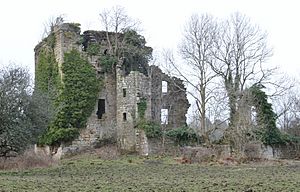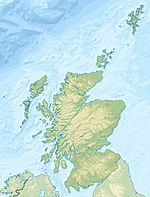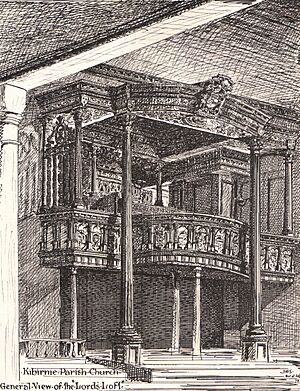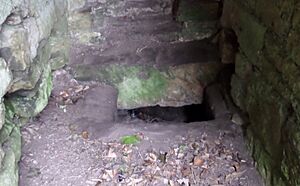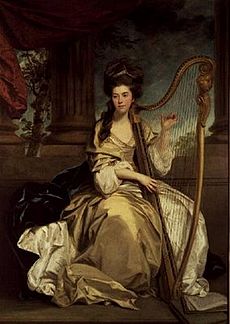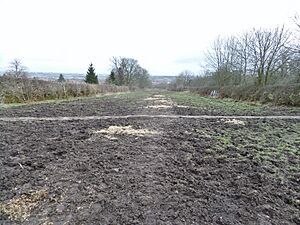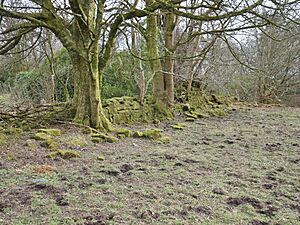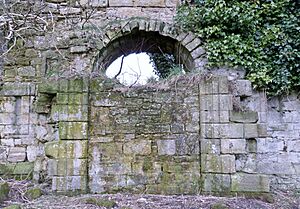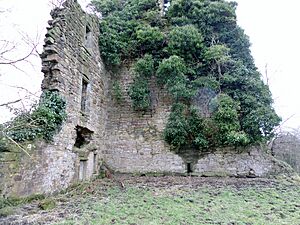Barony and Castle of Kilbirnie facts for kids
Kilbirnie Castle is an old castle and manor house located west of the town of Kilbirnie in North Ayrshire, Scotland. It sits on the lower slopes of the Glengarnock Hills. People also call it the Place of Kilbirnie, The Place, or Kilbirnie House.
The castle is near a stream and a deep ditch, which helped protect it long ago. The land around the castle used to be beautiful gardens. These gardens are now part of the Kilbirnie Place Golf Club, which opened in 1925.
Contents
History of Kilbirnie Castle
The name "Kilbirnie" comes from the Gaelic language. It means "Church of St Brendan". The area was once split into three large land sections called baronies. Kilbirnie was the biggest of these, with lots of good land for farming and forests.
People say that in 1263, Scottish soldiers gathered at Kilbirnie Castle. They were led by King Alexander III. They were preparing to fight Norwegian forces in the famous Battle of Largs.
The castle is built on high ground above a deep ditch. This gave it some natural protection on its west and north sides. In Scotland, a "place" (like "Place of Kilbirnie") means a large house owned by a wealthy landowner. It's similar to the word "palace."
Kilbirnie Castle has two main parts. One part is a strong defensive tower built around 1470. It was made for Malcolm Crawfurd and his wife, Marjory Barclay. The other part was added in 1627. This newer section was a more comfortable home with fewer defenses. It has a unique porch at the front.
Old maps show the castle changing over time. A map from around 1604 shows "Kilbirnan Castle" before the new wing was built. Later maps from the 17th and 18th centuries also show the castle and its surrounding features.
In 1707, two large land areas, Kilbirnie and Glengarnock, were joined together. Kilbirnie Manor House became the main building for this combined area.
The Castle Keep
The oldest part of Kilbirnie Castle is a very strong tower, built in the 15th century. It is about 42 feet long and 33 feet wide. Its walls are very thick, between 7 and 8 feet!
Inside the tower, there was a cellar and a sleeping area. There was also a large hall with three windows. A private room was located below the hall. The tower had four floors. In one corner, there was a small, dark prison called a "starving pit." You could only get into it through a hatch from a passage above. There were no holes for guns in the walls.
In 1602, someone broke into the castle when the owner was away. They stole things from the charter chest, which held important documents.
Near the tower, there are ruins of what might have been the castle kitchens.
Special Carvings
Inside the main fireplace of the tower, there are two red stone carvings. One carving clearly says 'Maria' in old writing. This might refer to the Virgin Mary. People believed these carvings could protect the house from bad spirits. This was a common belief in the past.
The old main entrance to the tower was on the east side. It later led into a courtyard.
The Mansion House
This newer part of the castle was built in 1627. It was added at a right angle to the old tower. It was a beautiful example of 17th-century building style. It had small towers with closets inside. The front door was set in a shallow area, and there was a narrow back door leading to a courtyard.
The old tower's hall might have been used as a dining room. The large room in the new mansion house was likely a drawing-room, a place for guests to relax. Sadly, part of the mansion house fell down sometime between 1956 and 1964.
The Great Fire
The castle buildings were destroyed by a big fire on May 1, 1757. This happened while some construction work was going on. A servant saw smoke coming from the roof and raised the alarm. The Earl of Crawfurd, his baby daughter Jean, and the servants barely escaped the fierce flames. The family then moved to another house nearby.
The story goes that a lady of the house accidentally started the fire. She threw hot grease into a fireplace, and it set the dirty chimney on fire. The fire quickly spread into the new mansion wing because workmen had left windows open. The keys to the house were also missing, so no one could get in to fight the fire. Many people came to help, but it was too late. For many years, people thought the fire was caused by supernatural forces. The real reason was kept secret until the Earl died in 1781.
Some parts of the castle were kept for a while and used as a hunting lodge.
Beautiful Gardens
The castle used to have a long, straight path leading up to it from the south. This path was called the 'Grand Avenue'. It was 20 yards wide and had high walls on either side. It led to large gardens. You can still see parts of this old avenue today.
There was also a big walled garden with two sections. It went down from the castle towards a deep ditch. This garden is now abandoned. Old maps show steps between the two parts of the garden. The gardens once grew flowers, shrubs, vegetables like potatoes and turnips, and had fruit trees. As late as 1856, maps showed apple trees in the walled garden. One of these trees was still alive in 2015!
The Castle Estate
The farm near the castle was called Place Farm, or sometimes Kilbirnie Place. The old castle site itself was called Kilbirnie House.
There was a spring called Birinie's Well about a quarter of a mile north of the castle ruins. This well provided excellent water. Water was carried to the castle through pipes from this well. The well was named after St Brendan, a saint from the 6th century who is also connected to Kilbirnie Church. The well is now covered, but its location is at the end of an old path.
Old maps also show a stone quarry nearby. There was also a small iron mine. In the late 1800s, there were even two curling ponds near the castle. Curling is a sport played on ice. These ponds are now drained and overgrown.
Auld Kirk of Kilbirnie
The local church, known as the Auld Kirk of Kilbirnie, has carvings on its tower. These carvings show the symbols of the Barclay and Crawfurd families, who owned the castle. The Crawfurds added a special section to the church called the Crawfurd Aisle in 1642. This part has beautiful carvings. It also has a private room and burial vaults for the family underneath.
Families Connected to Kilbirnie Castle
Over the centuries, several important families owned Kilbirnie Castle.
The Barclays
The castle originally belonged to the Barclay family. It passed to the Crawfurds when Marjory Barclay, who was the last of her family line, married Malcolm Crawfurd. Marjory was the daughter of Sir John Barclay. The Barclays of Kilbirnie were likely related to the ancient Barclay family of Ardrossan.
The Crawfurds
In 1470, Thomas Crawfurd gained the castle through marriage. His family was from Loudoun Castle. Sir John Crawfurd, a later owner, was knighted by King Charles I in 1642. He fought in the Civil Wars but died without children. The estate then went to Margaret Crawfurd, a distant relative.
In 1810, a man named John Crawfurd tried to claim the estate. He even changed his name to Lindsay. He said he was related to the family through a false story about an ancestor who had to flee to Ireland. After a lot of investigation, his claim was found to be completely untrue.
The Lindsay Crawfurds
Margaret Crawfurd married Patrick Lindsay. He was the second son of the Earl of Crawfurd. Patrick took the name Crawfurd of Kilbirnie, as the estate rules required. Sadly, Margaret and Patrick died only three days apart in 1680 from a serious illness. Their eldest son, John, inherited the castle in 1690.
John Crawfurd became an important leader in the area. In 1705, Queen Anne made him a Viscount. He died in 1708. He had two sons and three daughters. The family line continued until George Lindsay Crawfurd inherited the estates. He was the 20th Earl of Crawfurd. When he died in 1808 without marrying, the estates passed to his sister, Lady Mary Lindsay Crawfurd. She also died unmarried in 1833.
The Boyles
In 1833, George Boyle, the 4th Earl of Glasgow, inherited the ruined castle and house. He was related to the family through Margaret Crawfurd's eldest daughter.
The Knoxs
Later, when the Earl of Glasgow's estates were divided, Sir James Knox bought the castle and its lands.
Place House
A new house called Kilbirnie Place, or Place House, was built between 1892 and 1894 for Sir James Knox. It was designed by Henry Lord of Manchester. This house has since been torn down, and only its smaller buildings remain today.


